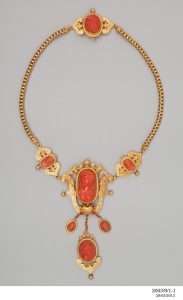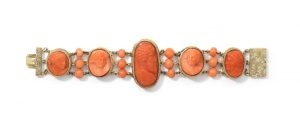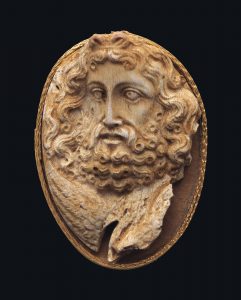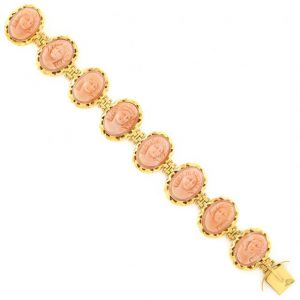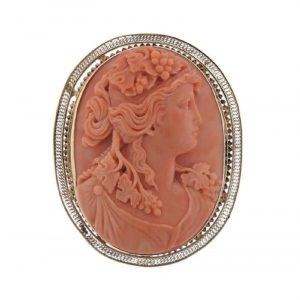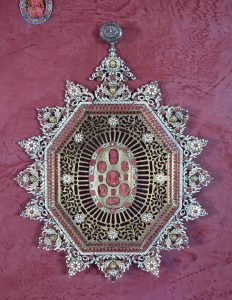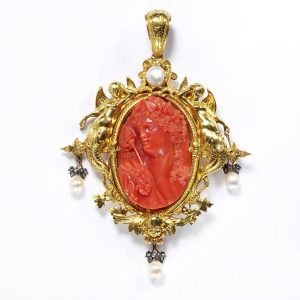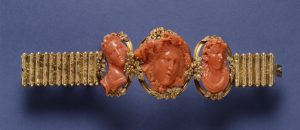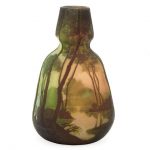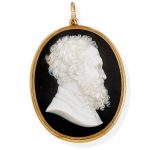Coral has been used in jewellery since antiquity. Believed to be an amulet which could protect against the evil eye, it was often worn by children or used in rosaries. In the early 19th century, it began to be exploited in conventional jewellery and became highly fashionable. According to the 19th century French jeweller Henri Vever ‘Every day, the coral merchant of H.R.H. Madame, Duchesse d’Angouleme, offers the most elaborate and elegant parures to customers and passers-by: the jewels which are sold there are created with exquisite taste’. Reference: Victoria & Albert Museum
Red coral (Corallium rubrum) cameos were a popular choice for fashionable jewellery in the 1840s and 1850s reflecting popular interest in the natural world and past styles. The making of shell and coral cameos is believed to have originated in Sicily and much of the coral jewellery made during the 1800s was produced in Italy. Reference: Museum of Applied Art and Sciences.
The ancient fishing port of Trapani on the west coast of Sicily was renowned in the 16th-18th centuries for its production of objects made from local red coral. Most common were capezzale, devotional plaques with religious figures set in engraved copper frames with rich coral inlay and enamel decoration. Other work included liturgical items such as chalices and crucifixes, as well as secular objects like jewelry, inkstands, and small caskets, many of which made their way into European kunstkammern. Reference: Sotheby’s
Coral and embossed gold parure Made in France, c.1840. A parure is a matching set of jewellery, usually a necklace, brooch, earrings and bracelets, and sometimes a hair or bodice ornament. First made and worn in the 1500s, parures were revived in the late 1700, and they took pride of place in the jewellery caskets of society women well into the 1800s.
This Renaissance-inspired parure includes a necklace, a large brooch, a hair ornament, a bangle and eight smaller bow brooches. It was made for wearing in the evening for formal occasions and would have suited the low-necked gowns and elaborate hair styles in fashion. It was likely that the smaller brooches were worn during the day on the sleeves and bodice of a woman’s dress. There are 30 coral cameos in this parure.
Reference: Museum of Applied Art and Science
A coral cameo bracelet, circa 1835-1850 Collet-set to the centre with an oval coral corallium rubrum cameo of Zeus, his back slightly turned and looking right, between smaller cameo busts facing him, connected by coral beads, reverse of clasp engraved with memorial attributions, length 18.2cm, fitted case
Sold for £1,750 inc. premium at Bonhams in 2016
A GREEK CORAL CAMEO OF ZEUS GREEK GOD HELLENISTIC PERIOD, CIRCA 2ND CENTURY B.C. 47 mm. long
Sold for GBP 25,000 at Christies in 2017
Gold and Coral Cameo Bracelet 8 coral cameos, ap. 46.7 dwts. gross. Length 7 1/4 inches.
Sold for $1,125 (includes buyer’s premium) at Doyle New York in 2018
14K Gold Carved Coral Cameo Brooch Pendant METAL: 14K gold. GEMSTONES: carved coral. MEASUREMENTS: brooch/pendant is 64 x 52mm at widest point. One edge is bent.
Sold for $500 at Hampton Estate Auction in 2018
A Trapani coral inlaid and enameled plaque inlaid with ten cameo portraits, late 17th century height 18 1/4 in.; width 14 1/4 in. 46 cm; 36 cm
Sold for 25,000 USD at Sothebys in 2018
Pendant with a coral cameo depicting Bacchus, the sculpted gold frame decorated with winged mermaids and hung with pearls and diamond sparks.
Many 19th century designers used historical styles. This piece looks back to the elaborate pendants of the Renaissance with their intricately sculpted gold. It has two matching brooches. The pendant and brooches were probably one of the last sets of jewellery to be sold by the Paris jeweller François-Désiré Froment-Meurice before his death in 1855. This pendant is similar to an item his widow showed at the Paris Universal Exhibition in 1855. It is carved with a figure of Bacchus, the Greek god of wine.
Reference: Victoria & Albert Museum
These heads of Bacchus, the Roman wine god, and two female followers, known as bacchantes, are carved from highly prized red coral.
Reference: The Walter Art Museum
